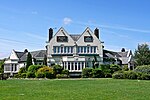All Hallows Church, Bardsey
Anglican Diocese of LeedsChurch of England church buildings in West YorkshireGrade I listed churches in Leeds

All Hallows Church in Bardsey, West Yorkshire, England is an active Anglican parish church in the archdeaconry of Leeds and the Diocese of Leeds. The Bardsey Millennium Tapestry, created by many people from the village, is hung at the west end of the north wall of the church. The tapestry took nearly five years to complete and was officially unveiled in October 2001.
Excerpt from the Wikipedia article All Hallows Church, Bardsey (License: CC BY-SA 3.0, Authors, Images).All Hallows Church, Bardsey
Church Lane, Leeds Bardsey cum Rigton
Geographical coordinates (GPS) Address External links Nearby Places Show on map
Geographical coordinates (GPS)
| Latitude | Longitude |
|---|---|
| N 53.882972222222 ° | E -1.4453611111111 ° |
Address
The Parish Church of All Hallows
Church Lane
LS17 9DN Leeds, Bardsey cum Rigton
England, United Kingdom
Open on Google Maps










